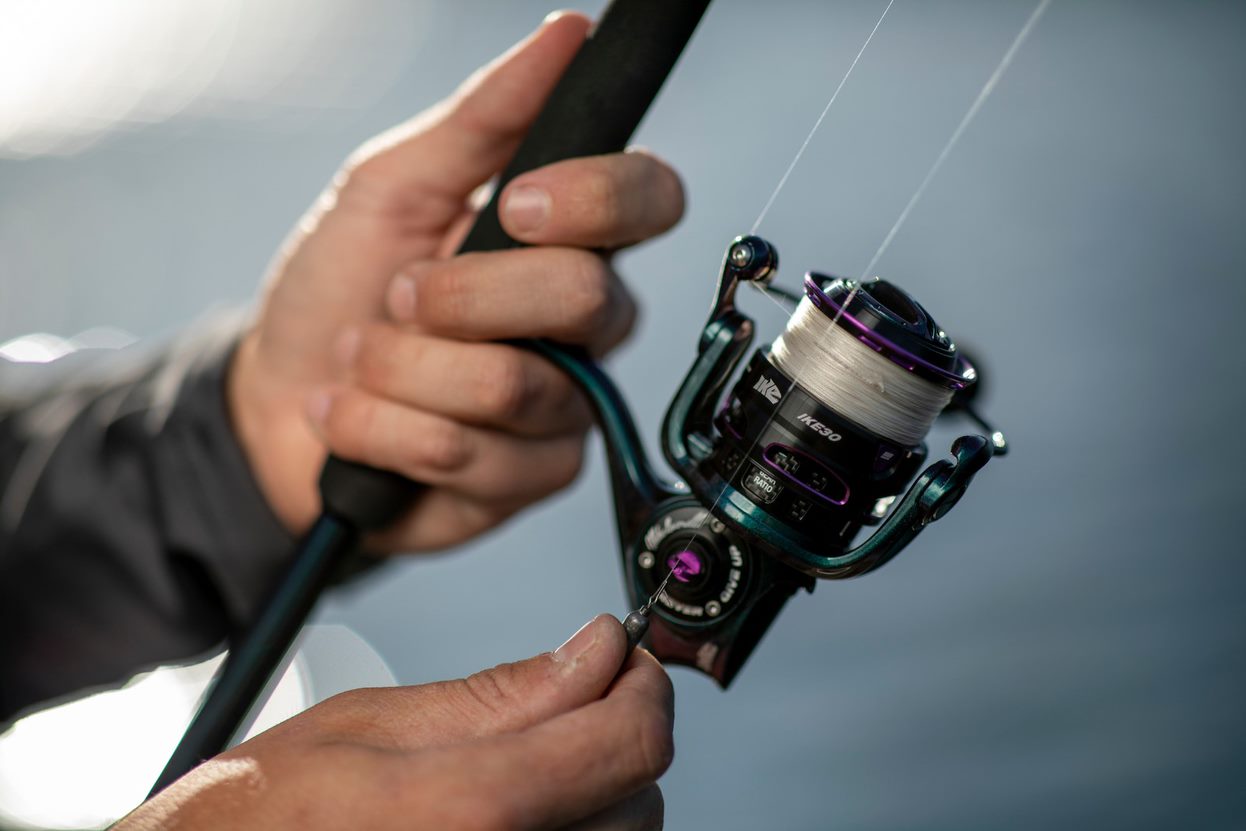We may earn revenue from the products available on this page and participate in affiliate programs. Learn More ›
Spinning reels may have a reputation for being easier to use than baitcasters, but that doesn’t mean they are entirely foolproof. While they may be more intuitive to cast, they aren’t immune to frustrating line twists, which can cause day-ending tangles. However, you minimize the risk by learning how to spool a spinning reel properly. Thankfully, spooling a spinning reel isn’t particularly complicated. All you have to do is follow a few simple rules.
How to Spool a Spinning Reel
Step 1: Tie Line to the Reel’s Spool

To get started, thread your line through the guide closest to the reel, open the bail, and then loop the line around the reel’s spool. Finish it off with a simple knot. It doesn’t have to be anything fancy. A basic overhand knot will do, since this will be the last time that knot sees the light of day (at least until you need to change the line). If you want something with a little more security, the arbor knot is relatively easy to tie and works almost any reel type. The video below walks you through it step by step.
Read Next: Best Spinning Reels for Bass
Step 2: Orient the Line Spool
Unlike me, who regularly forgets where I put my truck keys, monofilament and fluorocarbon fishing line has excellent memory. Because the line spends some serious time wrapped around the spool, first at the factory and then on the store shelf, it starts to take on the natural curl of the spool. To prevent twisted line, you’ll need to match this curl when you spool it onto your spinning reel.
Once you have the line tied to your reel, start reeling. You want the line to come off the spool in the same direction it goes onto the reel. Typically, that is going to be counterclockwise. If the proper direction is not immediately apparent, start reeling. If you start getting “pigtails” or “curlicues” at the entering guide, then it means that you are going in the wrong direction. Simply flip the spool of new line over and start reeling again.

Step 3: Add the Line
Adding a little tension, especially when you first start reeling new line onto the spool will ensure it lies flat and goes on tight. Loose gaps in the line will only cause problems once you’re on the water. Let the line run through your fingers to provide some light tension.
Fishing line spoolers (like this model from KastKing) are a good investment if you need to spool a ton of reels and want to spare your fingers.
Be careful not to add too much line to your spool. Don’t keep adding line right up to the edge of the spool lip. Instead, leave about an ⅛ inch of the spool empty. That extra space will help the line come off the spool smoothly during casting rather than coming off in large coils resulting in a bird’s nest.
Some tackle shops and sporting goods stores have high-speed electric spoolers that can fill a reel faster. While it can be tempting to use a high-RPM machine to fill a reel (especially the high-capacity variety), spooling too fast can create serious friction on your line. Friction can compromise the integrity of the fresh line you just had spooled. Sometimes, these machines wind the line too tight, which will compact it on the spool and cause casting issues. The best way to spool a reel is to do it the old-fashioned way and use your hands.
Read Next: Best Fishing Lines
When to Use Backing for Braid
If your reel has a non-slip, braid-ready spool, you can skip the backing and spool your braid right to your spinning reel. If it doesn’t, you should use a monofilament backing to prevent the braid from slipping around on your spool. Once you lay enough mono to create a few layers over the spool, tie a uni to uni knot to attach the braid. Then, keep reeling until the rest of the spool is mostly full.
Read Next: How to Tie the Alberto Knot

Tips to Avoid Line Twists and Reel Spooling Problems
- While most spinning reels enable you to close the bail by turning the reel handle, get into the practice of closing it manually after each cast. This will keep the line in tight loops without any slack.
- Never reel against the drag. If a fish is taking line and you’re afraid it will break, loosen your drag so that it slips appropriately, or back reel to prevent breakage.
- After each use, treat monofilament, copolymer, and fluorocarbon lines with a line conditioner. Spray it on your guides in sub-freezing temperatures to prevent them from gathering sharp ice.
- When in doubt, change your line. It’s your most direct connection to the fish, so if twist or memory inhibits casting distance or breaking strength, be sure to re-spool. Even with a premium line, it’s cheap insurance against losing the fish of a lifetime.
Final Thoughts on How to Spool a Spinning Reel
Knowing how to spool a spinning reel the right way can save you a ton of angling frustration in the long run. Following these tips will help you feel more confident about replacing your fishing line when the time comes. The more you fish, the more often you should swap out your line since regular use can cause abrasion, weakening the line and making it more prone to breaking. Also, sunlight can weaken your line over time, especially monofilament and fluorocarbon which degrade faster than braid.
Consider it a chore like changing your oil. It should always be part of regular vehicle maintenance, but the more you drive your truck, the more often you should change your motor oil. The same holds with fishing line.
